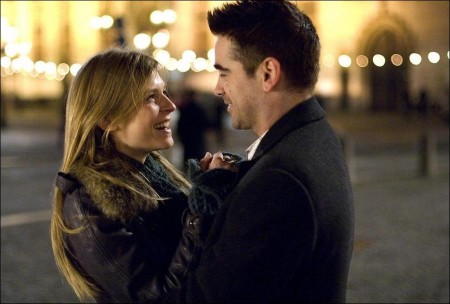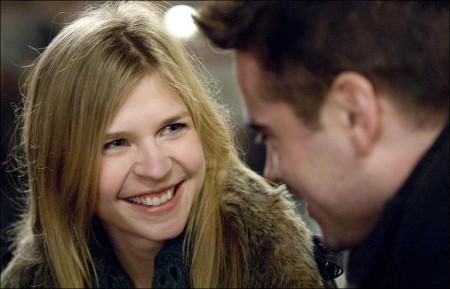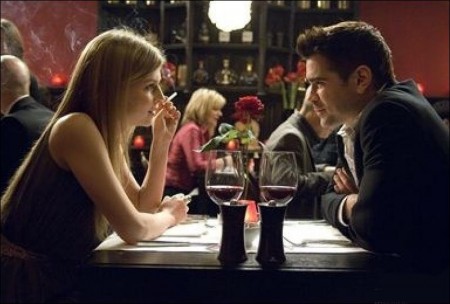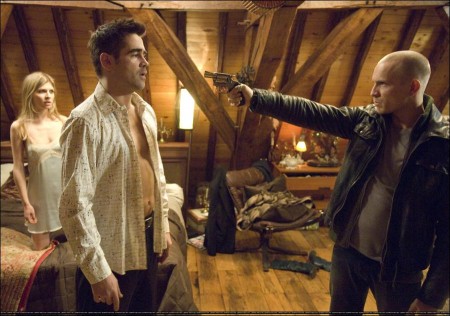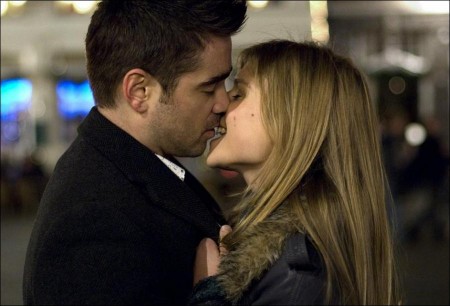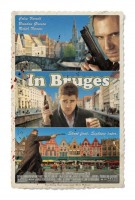Tagline: Shoot first. Sightsee later.
Ray and Ken are hit men and their boss send them to Bruges to wait until he is ready for them. But their surrounding is very different for them and they feel out of place. They find their experience surreal and encounter some weird situations and when their boss calls, their vacation becomes a life-and-death struggle.
In Bruges (pronounced “broozh”), the most well-preserved medieval city in the whole of Belgium, is a welcoming destination for travellers from all over the world. But for hit men Ray (Colin Farrell) and Ken (Brendan Gleeson), it could be their final destination; a difficult job has resulted in the pair being ordered right before Christmas by their London boss Harry (Ralph Fiennes) to go and cool their heels in the storybook Flemish city for a couple of weeks.
Very much out of place amidst the gothic architecture, canals, and cobbled streets, the two hit men fill their days living the lives of tourists. Ray, still haunted by the bloodshed in London, hates the place, while Ken, even as he keeps a fatherly eye on Ray’s often profanely funny exploits, finds his mind and soul being expanded by the beauty and serenity of the city.
But the longer they stay waiting for Harry’s call, the more surreal their experience becomes, as they find themselves in weird encounters with locals, tourists, violent medieval art, a dwarf American actor (Jordan Prentice) shooting a European art film, Dutch prostitutes, and a potential romance for Ray in the form of Chloe (Clemence Poesy), who may have some dark secrets of her own.
And when the call from Harry does finally come, Ken and Ray’s vacation becomes a life-and-death struggle of darkly comic proportions and surprisingly emotional consequences.
About the Production
For Academy Award-winning writer / director Martin McDonagh, In Bruges began to take shape in Bruges (pronounced “broozh”) during a weekend in the city. Located in Belgium, about an hour from Brussels, Bruges was an important trading city in the Middle Ages, and became hugely wealthy. Its fortunes waned, but its historic architecture, art, and canals remained; towards the end of the 19th century, it became a popular tourist center.
McDonagh remembers, “While I was first there, about four years ago, I had diverging feelings about the place. I started thinking of two characters who might respond to Bruges in distinct ways, and I started writing about them, with specific parts of Bruges for them to interact in and around.”
Producer Graham Broadbent and Pete Czernin read the script and, remarks Broadbent, “thought the script was an amazing piece of writing; dazzling dialogue with a compelling story and wonderful roles. On visiting Bruges itself, you could see that it would be an additional character in the story; the city has such a heightened atmosphere and it’s so picturesque, whichever way you pointed a camera it was going to look extraordinary.”
Actor Ralph Fiennes comments, “The restlessness of these characters, set against an old, beautiful, well-preserved little European city makes for a perfect counterpoint. Martin has a very particular voice – in his writing, the humor delicately coats his completely rounded characters. As a director, he proved to be smart and generous.”
The production came together quickly; within a year of McDonagh meeting with the producers, the film had found a home at Focus Features and casting was being finalized. Even more fortuitously, what with the “Venice of the North” – as Bruges is known – being conceived as intrinsic to the story and the film, the city welcomed the cast and crew. Broadbent notes, “We asked for, and were given, direct access to many of the specific actual locations that Martin had set his story in. The mayor’s, Tourism, and City Film Offices all made it possible for us to shoot there.”
Actor Brendan Gleeson laughs, “When we arrived here, we met the mayor, and I said, ‘Thanks for lighting our set, Mr. Mayor.’ Because that’s what it’s like there; it’s as if somebody built a magnificent movie set and said, go shoot. It’s so picturesque and stunningly romantic to look at.”
However, McDonagh clarifies, “As the film progresses, Bruges becomes darker and its Gothic qualities come to the fore. The night scenes showcase that even earlier, such as when Ray happens upon the Hieronymus Bosch-inspired movie set.”
Production designer Michael Carlin adds, “The set echoes a Bosch painting that you glimpse elsewhere in the movie – that Ray is seeing.
“Bruges itself is a key character that changes throughout the story. It starts out as fairly benign, then becomes almost as sinister as Harry [Ralph Fiennes’ character] – bearing out Ray’s anxieties.”
Colin Farrell read the script and found himself “laughing out loud. But it was also heartbreaking because I think you really do care for each and every character.
“Pound for pound, it was the best thing I’ve ever read. Martin’s got some brain on him. It’s just brilliant, the characters and the situations – unique, and with amazing dialogue.”
McDonagh reveals, “I didn’t write the parts for anybody specifically. In fact, originally Ray and Ken were written as Londoners; I only changed them to Irish after we’d cast Colin and Brendan. Everything seemed to fall into place after that – their camaraderie, their antagonism towards Harry.
“One of Brendan’s strengths as an actor is that he makes everything sound and seem so naturalistic, like he’s just making it up on the spot. Also, his natural warmth and humanity, and his joy of life, shine through in most everything he does.”
By his own account, Gleeson was already “pretty well-acquainted” with the writer / director, having starred for McDonagh in his Oscar-winning short film Six Shooter and being an admirer of his plays. The actor states, “I cannot think of anybody, in any of his plays or his screenplays, whom you actively and completely despise. There is a soul to his work. It’s robust yet delicate. You have this combination of the worst of humanity, speaking the most conscience-free dialogue, and yet – you leave with a feeling of connection to these people. The fact is, they are all too human.
“A cynic can quite easily despise his characters and allow his audience to as well, dismissing them as being inhuman. The value of Martin’s storytelling is that, however apparently inhuman the behavior, all of it is borne out in the history of human beings. Watching one of his works, we find that we can’t just disconnect and despise; we must engage with these people. That’s a challenge and a very fine line for an actor.”
Farrell says, “There is a purity to these characters, what with their humor and how they view the world. Yes, they bring death to people, but they’re not black-and-white.”
Broadbent remarks, “You don’t expect to embrace these characters, to care what is going to happen to them – particularly Ken; here’s a man who has killed many people, yet you come to feel for him, to value him as a person and as a mentor for Ray.”
McDonagh adds, “All the characters are looking for answers, each in his own way. By the close of the story, hopefully the viewer will have an understanding of what has driven them – the reasons behind the actions they have taken, including those prior to their time in Bruges.
“Ken and Ray did not know each other very well prior to the London hit, and now they are forced to live together in this strange place. After initially feeling ill at ease with each other and the city, they become close as they find things out about themselves and about each other.”
Broadbent offers, “In Ray we see someone who has danger in him, but is also sensitive, vulnerable and full of remorse; in many ways the opposite of the ruthless hit man we might have expected.”
McDonagh notes, “Ray had to be dangerous and unpredictable, but also sensitive and dark and almost despairing at times. I’d seen Colin do dangerous and unpredictable before, and as soon as we met up and talked over the character, I knew he had all those other things in spades too.
“But it takes a lot of guts and talent to put all those sadder and more vulnerable aspects up on-screen and not have it be mawkish or sentimental – and I think Colin did that brilliantly.”
Broadbent comments, “While this is a film about hit men and their violence, loyalty, and honor, Martin also catches the innocence in them and accords them great affection. This is most easily seen in the relationship between Ken and Ray. We see that they really care for each other. Ultimately, Ken offers – and is offered – the opportunity for redemption.
“That’s where Brendan is so key to this film. He conveys great strength and compassion, and shows you that a warmhearted hit man does not have to be a contradiction in terms.”
For his part, Gleeson feels that “standing up for Ray in this city, at this time, liberates Ken to be able to envision hope and faith again for his own existence – one that has been so full of violence, which he’s very good at, for so many years. He does what he does for Ray because he’s been given the gift, from this young lad, of hope.”
Of Ken’s relationship with Harry, McDonagh reveals, “They share a past. Harry is a very dangerous individual, yet there is an intimacy to his friendship with Ken, and a trust stemming from a sense of loyalty between them.”
Farrell remarks, “Harry is violent and aggressive in his approach to things, but with Ralph playing him, you see the nuances that Martin layered into the character – and he’s very funny as well.”
Fiennes elaborates, “Harry has sent these two to Bruges as part of his own private reckoning. He intends to balance the books in his moral universe – which is quite a violent one.”
McDonagh notes, “For Harry, I wanted someone who hadn’t done the archetypal working-class London gangster type a hundred times before. I wanted a very good actor who would have a different and more surprising take on it. It wasn’t until I got on the set that I realized how bloody scary Ralph can be.”
Broadbent says, “Ralph’s performance shows you this chilling psychopath, but also the honor code that he has. Ralph had a lot of fun with Martin’s dialogue and finding an accent with him for Harry’s character.”
Regarding her character, Clemence Poesy muses, “I think Chloe is maybe the only positive aspect of Ray’s life at a certain point in the story. There’s a spark between them, and he realizes, well maybe I have got something – someone – to live for.
“Reading the script was like entering Martin’s universe – with things you’ve never heard or seen – and I just wanted to be a tiny part of it. I thought, ‘I want to say those lines.’ The first read-through was so enjoyable in and of itself. On the set, Martin has a great sense of humor and makes you feel that you’re creating something together.”
“He’s not ‘just’ a wordsmith,” states Carlin. “He’s very much a director. It’s often been said that his plays are cinematic. He saw In Bruges in his head, and had a clear idea of what he wanted up on-screen.”
Farrell adds, “It wasn’t just the words; he preconceived a lot of the actions, the physical movements – particularly for my character. He has a great understanding of space, too.
“As a director, Martin is compassionate and actually seems to enjoy all parts of the moviemaking process.”
Cast as the film-within-the-film actor, Jordan Prentice says of his character, “Jimmy only adds to the unavoidably surreal nature of the whole place and experience for Ken and especially Ray. He’s very disgruntled, angry soul – and, as an actor, I loved playing the scenes where Jimmy voices his bizarre theories. It was a rich role for me, and a great opportunity – given the richness of Martin’s script – to explore a character.
“Martin is a creative, warm-spirited fellow – with just enough crazy in him to make him someone I like! I see him in many of the characters…”
Thekla Reuten, cast as the pregnant hotel owner Marie, comments, “Marie represents the good amidst all the darkness in the story. What I liked about the story – aside from how funny and well-written it was – was that you see how the characters begin to feel within themselves the effects of the acts of violence that they have done. Not like in so many movies, where it’s ‘cool.’ Although, it is quite exciting seeing men with guns running around the city’s picturesque, lovely streets – what a contrast…
“I’d seen some of Martin’s plays translated and staged in Holland. As a filmmaker, Martin kept an eye on everything and everyone without losing his concentration. Speaking as an actor, one can really communicate with a director who thinks dramaturgically – which Martin does.”
Further taking a page from the theater, McDonagh made sure to convene the actors for a three-week rehearsals period before filming began.
The writer/director notes that “Colin and Brendan had met before socially, I think, but never worked together, although I understand they’d always wanted to. During the rehearsal process; they got on like a house on fire and their respect for each other was total.”
Gleeson calls the time spent rehearsing “a great gift. At times, I felt I should have bought a ticket at the door, given the quality of Colin’s work. I’m proud he’s an Irishman, and I’m proud he’s a young actor in our profession. He and Martin were made for each other. We all tackled the text so it was really solid before we began shooting.”
McDonagh adds, “Mostly, our rehearsals were about us analyzing all aspects of the characters’ histories and relationships to each other. We would find out why they were doing and saying what they were doing and saying at each given moment. This seems pretty simple, but it’s surprising how helpful this was, to me as much as anyone.”
Poesy enthuses, “Rehearsing was an incredible luxury, but also so important to Martin. It gave us time to get to know each other; I could see how Colin works before we got to the set. As it turns out, he’s always trying to find the truth of his character, so when it’s time to actually shoot he goes instinctively into scenes.”
Jeremie Renier, who plays Chloe’s potentially dangerous ex-boyfriend Eirik, seconds, “Colin is instinctive – like an animal! Martin is very precise, and the rehearsals helped me because this is the first role I’ve ever had to speak so much English for. It was a real opportunity for me. “Also, I’m from Brussels, so I didn’t have far to go for this movie, which was helping not only Bruges but also the Belgian film industry.”
With unprecedented cooperation and support from Bruges – including burgomaster Patrick Moenaert, whose position is the mayoral equivalent, and hundreds of locals working as extras – filming commenced in early February of 2007 and lasted for two months. A couple of other projects, including one other major feature film (Fred Zinnemann’s 1959 The Nun’s Story, starring Audrey Hepburn), had shot on location in Bruges over the years. But the In Bruges production and access was by far the most extensive to date.
“We had the good will of the entire city, every day,” marvels Broadbent. “And we knew we were being ambassadors for film, so all of us – unlike the characters – were nice to everyone!”
Fiennes laughs, “The unit got around easily; since it’s mostly pedestrians and horse-drawn carts in Bruges, the cars for the production had the run of the city.”
Cinematographer Eigil Bryld also had the run of the city, sometimes literally; McDonagh emphasized handheld work for many of the exterior location sequences, with the director of photography often eschewing formal compositions.
Carlin notes, “Some of the shoot was like well-organized guerrilla raids. We didn’t have to change or dress many of the locations we shot on. The city did let us put Christmas decorations, trees, and lighting back up – and take them down again – even though the holiday had come and gone.”
The many real-life Bruges locations “playing themselves” in the film will give moviegoers the impression of having been on a two-hour vacation in the city. McDonagh laughs, “Watching this movie, you may well find yourself asking yourself, ‘What is this place?’ – just like our characters are.”
Farrell, echoing his character, says, “Bruges is otherworldly, and like nowhere I’d ever been to before. Personally, I found there was a real heaviness to the city.”
McDonagh reports, “We got the all-clear to film in just about every stunning location I wanted, and you will see so much of the city in the picture. Aside from one church, we were allowed to film in or outside every single location I wrote into the original script. That says a lot about how helpful the people were.”
When pressed to name a favorite location, McDonagh cites not one but three. He notes, “The boys’ hotel was actually the same hotel I stayed in on my first trip, before I had any inkling I’d write something set in Bruges. I loved the market square, where most of the action takes place.
“But I also loved filming on the canals. It was such a beautiful blue-skied cold and misty morning. We scrambled to get rolling before the mist lifted, and I think we got some lovely stuff that day.”
The production’s nearly all-access pass meant that parts of Bruges will be revealed on-screen even to those familiar with the city. A particular standout – in all respects- is the Bell Tower, which looms 83 metres high (or, over 250 feet tall). 366 steps must be climbed to reach the pinnacle, where in the belfry one is then rewarded with a breathtaking view of all of Bruges and the surrounding countryside.
The on-screen film shoot / set that Jimmy and Chloe are (in very different ways) a part of was situated primarily outside the Gruuthuse Museum (which houses artifacts and objects spanning the 15th century to the 20th). This is not to be confused with the Groeninge Museum, where the cast and crew was allowed inside to film a conversation between Ray and Ken about purgatory.
The Groeninge showcases works by such legendary artists as Hieronymus Bosch, Rene Magritte, Jan van Eyck, among many others, and Colin Farrell and Brendan Gleeson found themselves happily occupied between takes strolling about the galleries.
Broadbent marvels, “It’s almost unheard-of for a movie shoot to be able to film in real galleries with so many valuable pictures. As it was, we had to take out hundreds of millions of dollars’ worth of insurance policies for the days we were there, to cover the possibility of any damage to the Groeninge’s amazingly valuable collection.”
Other locations included the “Lake of Love,” which used to be better known as Minnewater, a regular conduit between Bruges and Ghent, but is now more of a romantic rendezvous point; Jan van Eyckplein Square, by the Spiegelrei canal; the Bruges train depot; Cafedraal restaurant, where Ray takes Chloe out to dinner; Diligente bar, where Ken takes to drink; and Basilica of the Holy Blood, where Ken waits on line, the chapel of which contains the famous Relic of the Holy Blood. Due to concerns over the Relic, the production did receive a rare turn-away, and was obliged to film in a different church nearby.
The majority of the interiors – such as the residences of Harry’s contact Yuri and of Chloe – were and are in fact in Bruges. Whether in Bruges or not, McDonagh hopes that, with In Bruges, audiences will “experience a story that’s funny, sexy, and dangerous but at the same time sad, strange, thoughtful, and oddly joyous.”
McDonagh plans to visit the city again, confiding, “I actually can’t wait to go back to Bruges, but I think I’d better go before the film comes out there – ’cause they’re probably gonna kill me.”
Production notes provided by Focus Features.
In Bruges
Starring: Colin Farrell, Brendan Gleeson, Clemence Poesy, Ralph Fiennes, Elizabeth Berrington, Anna Madeley
Directed by: Martin McDonagh
Screenplay by: Martin McDonagh
Release Date: February 8, 2008
MPAA Rating: R for strong bloody violence, pervasive language and some drug use.
Studio: Focus Features
Box Office Totals
Domestic: $7,800,824 (26.3%)
Foreign: $21,905,478 (73.7%)
Total: $29,706,302 (Worldwide)
